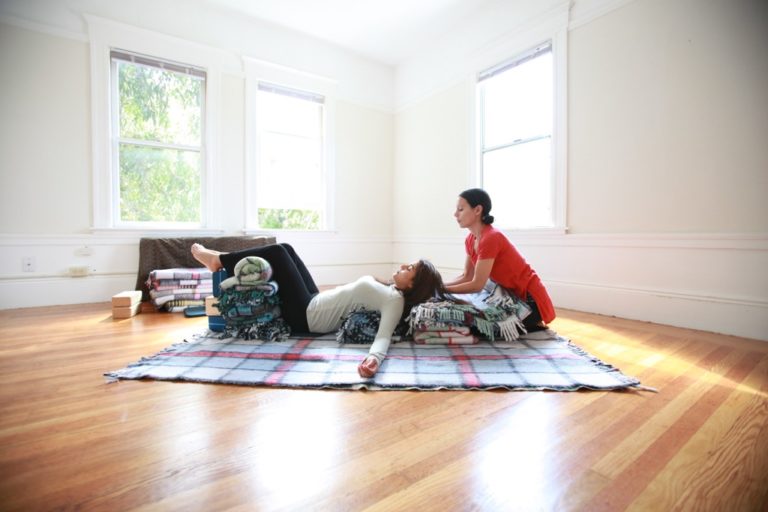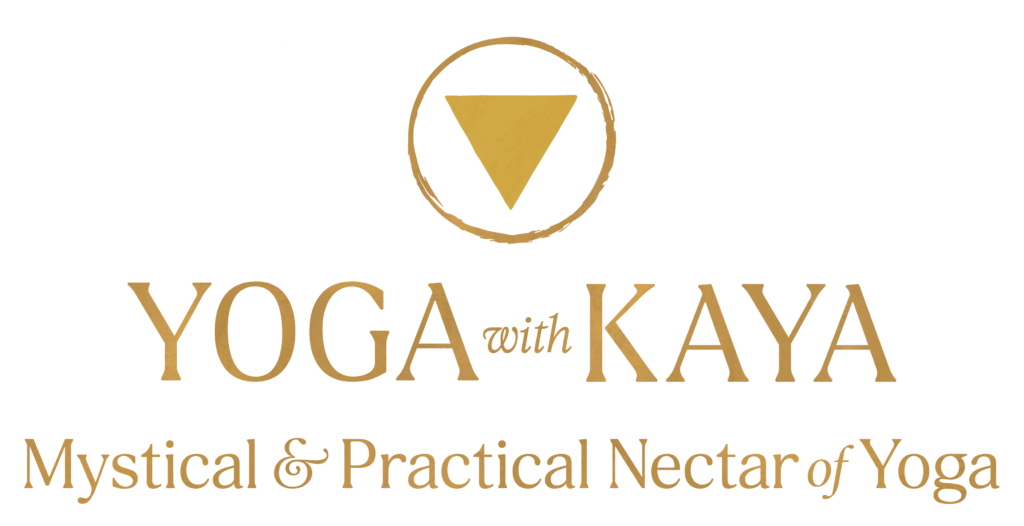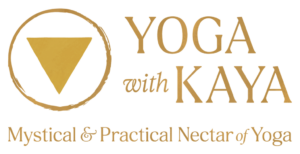Let’s talk about props.
In most forms of modern postural yoga, props are used as a “remedial measure”.
This means, if a student “can’t do” a particular āsana, the teacher provides a “gap filler” in the form of a prop. For example, if a student can’t reach the floor in a standing forward bend, they place a block or a chair under his or her hands, to “fill the gap” between their hands and the floor.
While this is a legitimate use of props, as a primary use of propping, it promotes a limited and problematic perspective on yoga.
The use of props as a remedial measure uphold the rampant misperception that yoga is about how far the body goes from point A to point B.
The conventional yogaland viewpoint about yoga is: the further, broader or more extreme the angles, the more advanced the practitioner. If the goal is to go further, then props are for “those who can’t”. A prop is viewed as something “for now”, until the goal of going accomplishing the āsana without a prop is reached in the future.
This plays out in yogaland anytime a teacher says / models “do this” without props, and then says “if you can’t do it, then get a prop and do it this way”. Props are a second or third choice, reserved when a student can’t achieve the “ideal”. This contributes to the notion that yoga is about achieving shapes. No matter what a teacher may believe to the contrary.
The truth is, your inner experience in yoga is not dependent on how far your body goes, how you look, how hard you worked, or how much you don’t need props.
In fact, striving to achieve a particular aesthetic shape actually blocks the inner unfoldment that is yoga’s purpose.
Yoga’s ultimate purpose is revelation. It rests on surrendering all desire and aversion so that the Self, as it is , is revealed. Even with regard to āsana this is true. Notably, Patañjali describes in the Yoga Sūtras that “Yogāsana is mastered through the abandonment of all effort}.
In SRY {Supreme Release Yoga} we are interested in yoga not as an aesthetic or athletic program, but as a surrender, rejuvenation, and spiritual growth program. Thus, props are a means to serve this purpose.
We do use props to “fill in the gap”, caring for the body by meeting it where it is. But that is just one reason to use props. And, even when we use a prop in this way in SRY, it is never because we are in-waiting or striving for the “someday when I can do the pose without the props”, Instead, we are supporting an inner unfoldment in a personalized angle that is taking place in the moment right now.
In SRY, we consider yoga’s purpose and capacity in everything we do. As such, we can think about whether a yoga āsana accomplishes a yogic means…
Here are a few key and interrelated reasons we prop in SRY:
- To experience Patanjali’s definition of the mastery of āsana – “to abandon all effort”
- To support the body fully so that it can relax, and let go deeply.
- To hold the body in specific angles that target designated areas for healing change, yet remain free from effort {the props hold you there}.
- To support the body so that the mind can let go. When the mind lets go it is available for Self-recognition.
- To protect hyper-laxity of the joints by preventing over stretching, and thus to induce truly supreme release.
- To reverse the tendency to push and force past blind spots, and instead back the body up into a place of true healing and transformation
- To deepen a pose by creating a womb-like experience.
In classes designed for a deeper experience, I use MORE propping {4-10 blankets per person}, not less. It is a primary part of the SRY approach, used to take yogis swiftly and directly to the inner journey of yoga.
Imagine being surrounded in a womb-like hug of yoga blankets, or being supported by firm and immoveable props that allow you to let go like a newborn being held in a parent’s arm.
The purpose of SRY is not how far does the body go from point A to point B, but rather, what inner resolve, relaxation, release, and rejuvenation can take place when I let go at the deepest level, and what do I discover when that occurs. The props are used to support that primary purpose.
It’s not that one should never make any effort in life or strive. Indeed, this is part of life. However, most modern people living a life in the world do not need MORE training in how to push, force, achieve and strive. If they do need help with this, you aren’t likely to find them in the local studio doing modern postural yoga.
Most often the students that “can” go the “furthest” in a pose are stretching or pushing past the point of healing and transformation. They may be avoiding something deep within. When they back out of those extreme angles and let go of effort they discover so much.
Speaking Āyurvedically, the yoga practitioners that love to push themselves {pitta type yogis}, or who flop easily and boundlessly into extreme angles {vata type yogis}, truly have a profound experience in the containment yoga experience.
Here are a few times when more props are especially helpful…
- You feel scared, hurt, alone.
- You feel ungrounded, unsafe, insecure or worried about the future.
- You have a tendency to push, strive or force.
- You have an overcommitment to achievement.
- You’re experiencing overwhelm or transition in life.
- You feel depleted, lonely, or run down.
- The weight of the world is resting on your shoulders
- Many responsibilities mean there it becomes nearly difficult to relax – even during sleep!
- Your mind is especially restless or busy.
- You’re anxious and having trouble settling down.
- Your body is experiencing increased pain, especially in your joints.
- You’ve been undergoing lots of change and instability – internally or in life.
- The weather is cold or windy, and you are feeling “bone cold”.
- You have been traveling or on the move a lot.
What if your yoga was about leaning in and letting go? What if your practice of yoga was about discovering the truth of your being that reveals itself when you stop trying to push, force or achieve? This is the essence of the SRY practice, concentrated in the use of props as a deepening measure, not a remedial measure.

Imagine being met where you are, held, loved, supported. Imagine becoming free from effort. This is the potential of props. Imagine what happens for your body, mind and heart when you are held, loved and supported?
I’ll share these words of one student as she built herself a meditation throne, “I used to think more props meant I was not good at yoga, now I KNOW more props mean I’m advanced!”
She understood that truly “advanced” in yoga is about being aware of what each moment calls for and tending to the need of the moment, loving yourself starting with the body, and being free from a sense of insecurity about needing support!
Want to deepen your practice with props? Here are a few recommendations:
- Back out of a pose halfway. Yes halfway.
- Use props {blocks and firm blankets are the best} to HOLD yourself at the mid-way point.
- Lean in.
- Let go.
- Notice what unfolds.
- Repeat.
Surrender is advanced. Self love is advanced. Freedom from inner pressure is advanced. That is yoga.
Love,
Kaya
Online SRY Studio
Weekly Live Yoga Classes Plus access to a library of practices and contemplations
Join Kaya for classes online, all the time. Experience the yoga you’ve been looking for – gentle but deep, advanced but accessible, soft but transformative.
Supreme Release Yoga {SRY} threads healing release of spinal tension, nurturance of your whole body as a field of awakening and meaningful yogic teachings from the oral tradition and ancient texts. This is a mature practice for dedicated yogis and teachers who are ready to go beyond “shape making” and the binary of stretch-strengthen. It is truly time to go within.


